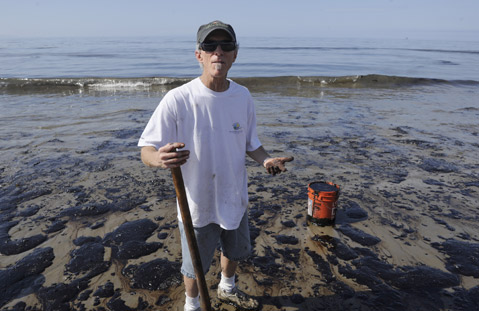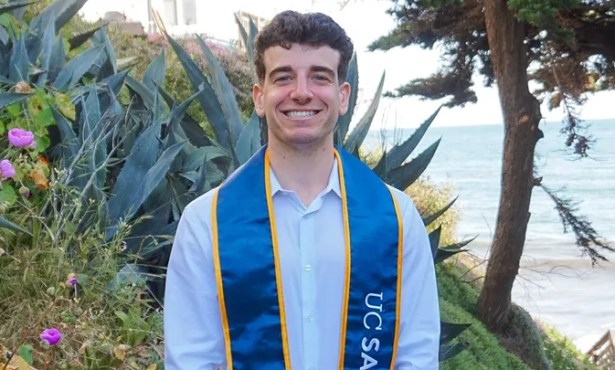Citizen Responders Rushed to Save Beaches
Outraged By Slow Response, S.B. Residents Brave Cops and Crude

The images are both heartwarming and heartbreaking: a dozen men and women, mostly strangers, clad in T-shirts and shorts, shoveling load after load of heavy, noxious oil off a spoiled beach shimmering in the morning sun.
Some formed a Sisyphean bucket brigade to scoop hundreds of gallons of crude from the sand, only to watch more wash up with the next waves. Others ran into the surf to cradle the blackened bodies of dying pelicans in their arms. Where were the professionals? Eighteen hours after a broken pipe had sent a river of oil into the ocean, why had no “official” arrived to help save Lorraine’s Beach?
At the time, the estimate was that 21,000 gallons had escaped, but according to area artist and citizen responder Ethan Turpin, that seemed incredibly low: “I was there for about an hour, and we filled 50 five-gallon buckets. Sadly, I must say, there is no way we removed one percent of that spill.” As it turned out, the spill was over 100,000 gallons.
The responders spontaneously began arriving all along the Gaviota Coast as early as 6:30 a.m. on Wednesday, alerted to the pipeline rupture by texts and news stories the day before. It was the images of their backbreaking work that were beamed around the world while a bureaucratically hamstrung task force of state and federal agencies slowly rolled out their cleanup effort.
Early in the afternoon, exhausted, the volunteers noticed a huddle of men standing around a truck and asked for a hand hauling their 50-pound buckets of oil. The men just stared and called back: “We’re Caltrans.” The citizen responders could only laugh and keep shoveling. As more would-be volunteers arrived and parked above the beach, CHP officers threatened them with tickets if they didn’t leave.
Tamlorn Chase, a Santa Barbara native and surfer who guides kayak tours along the Gaviota Coast, arrived at Lorraine’s around 11 a.m., shortly before two women showed up from Los Angeles to volunteer. The officers kept repeating that since the volunteers weren’t wearing proper safety equipment, they’d need to vacate the area. Those warnings went unheeded or were met with videotaped rebukes. No officially dressed responders had yet arrived.
“Of course we didn’t have proper gear, but no one else was cleaning,” Chase said, remembering a group of nesting snowy plovers chirping in panic and confusion as they skirted around the tar that covered their feeding grounds. Chase said he woke up the next day feeling a bit woozy and sore, but no worse for the wear considering the “grave” health concerns cited by officials attempting to keep residents off Refugio, El Capitan, and other nearby beaches.
Osiris Castañeda, a documentary filmmaker and community activist, explained as maddening as it was to be hassled by police and neglected by credentialed cleanup crews, the scene at Lorraine’s Beach that morning was inspiring: “There was a spirit of feeling like you were doing something that mattered, and doing it with people you had never met.” Castañeda proved convincing when, camera in hand, he successfully lobbied law enforcement officers to allow him and others to stay until the organized response arrived.
“I’m not critical of these people,” said Castañeda. “They were doing what they needed to do. But it was an interesting social experience. There’s a system here that’s broken just like that pipeline is broken.”
Deane Plaister, a member of the Surfrider Foundation’s executive committee, decided to check out Refugio Beach on his way to work Wednesday morning. Greeted by a media circus and unwelcoming Sheriff’s deputies, he caught a glimpse of a beach void of any workers. But as he drove down the coast, he saw people hustling toward the ocean with shovels and buckets. Despite a lingering case of bronchitis, he rolled up his sleeves and got down to business. It was particularly cheering to learn that two big corporate stores — Home Depot and OSH — had donated supplies to the citizen responders.
Normally media shy, Plaister said he felt the need to speak out after witnessing how long it took the government-run machine to power up. “Of course there’s going to be operational lag time,” he admitted, “but I couldn’t believe how slow they were.” Plaister said at least one member of the Lorraine’s Beach crew split the scene when she was threatened with arrest, but “I was just so pissed off, I thought, ‘When they put the cuffs on me, I’ll stop.’”
And even though he recognized the seeming futility of his efforts, Plaister kept thinking, “Every shovel of oil is one that won’t get on a bird. This damn scoop of oil isn’t going to be out there anymore.” Plaister said Santa Barbara ought to form some kind of on-call volunteer team that can suit up and respond to a local oil spill at a moment’s notice, and that the low-cost safeguard should be paid for by oil companies.



